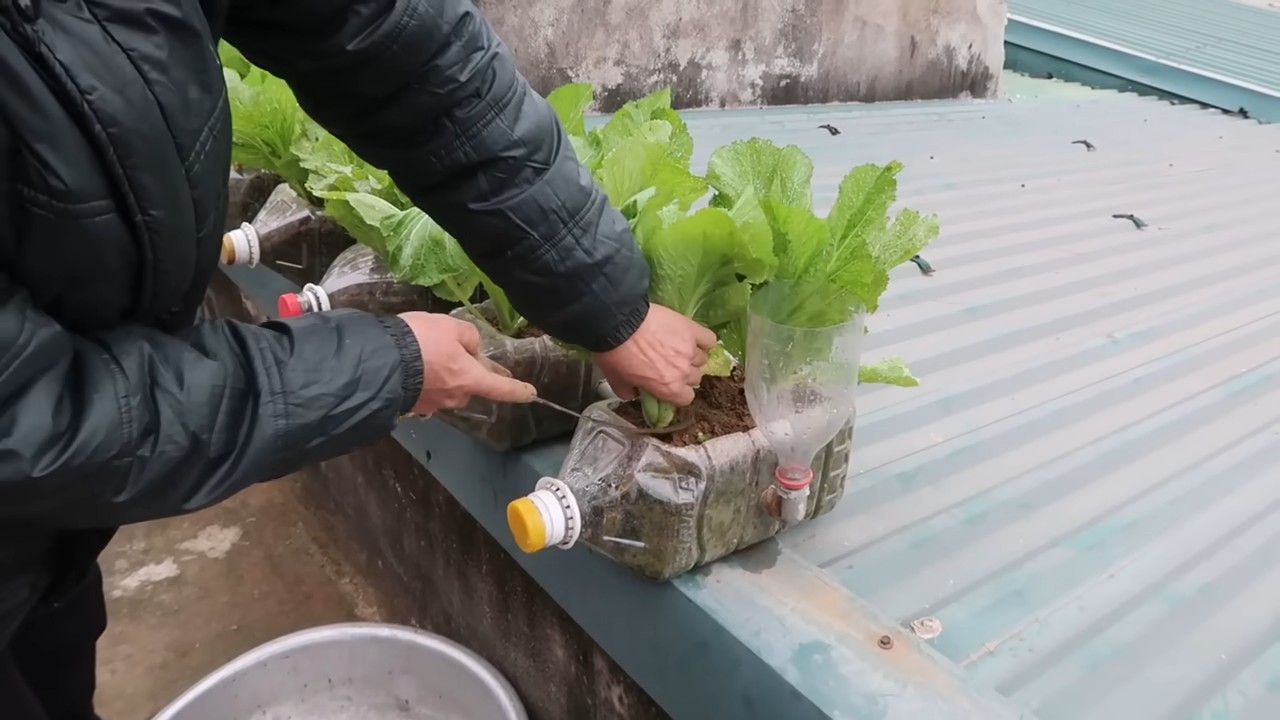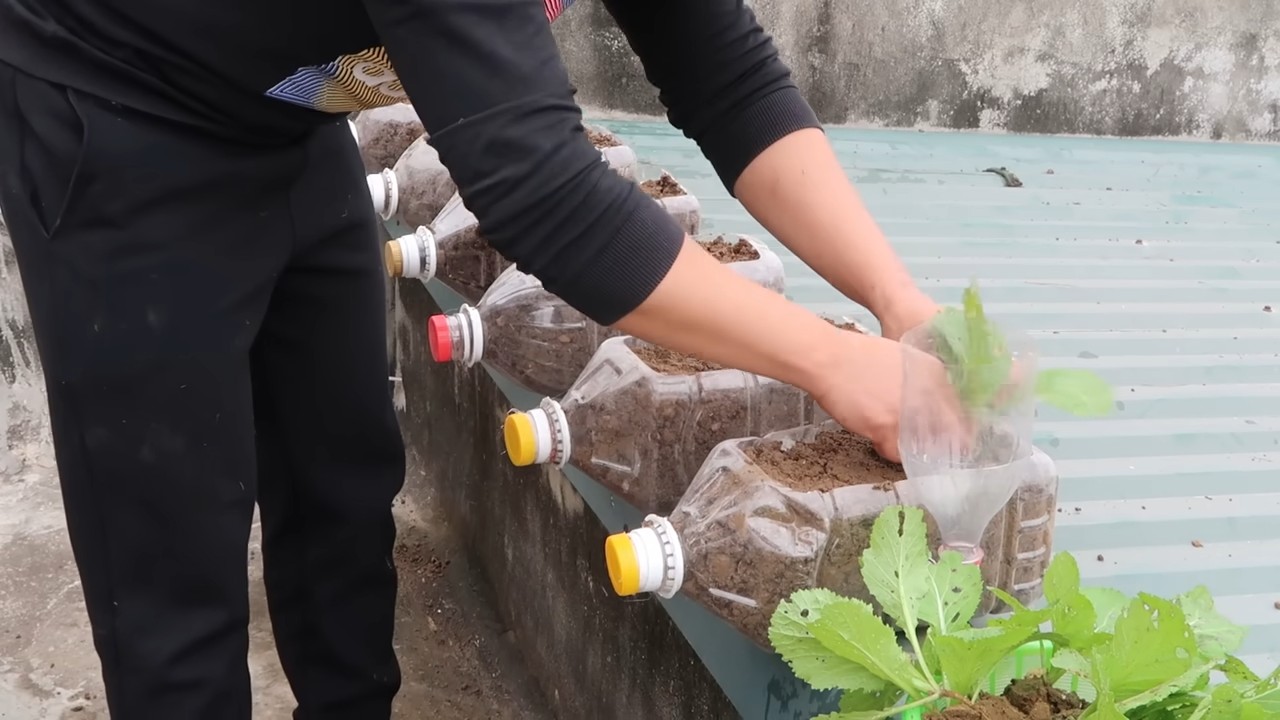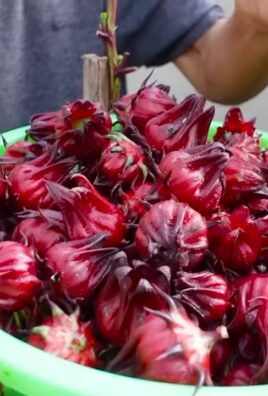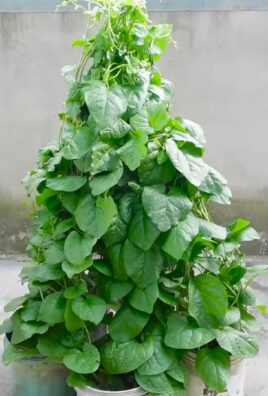Grow fresh veggies at home – imagine stepping outside your back door and picking a ripe, juicy tomato still warm from the sun, or snipping fresh herbs to add a burst of flavor to your dinner. Sounds idyllic, right? Well, it doesn’t have to be just a dream! For centuries, people have cultivated small gardens, from the elaborate kitchen gardens of medieval monasteries to the humble window boxes of city dwellers. This connection to the earth, this ability to nurture life and provide for ourselves, is deeply ingrained in our human spirit.
But let’s be honest, the thought of starting a garden can be intimidating. Where do you even begin? That’s where this DIY guide comes in! I’m here to share some simple, effective, and budget-friendly tricks and hacks that will empower you to grow fresh veggies at home, no matter how small your space or how green (or not-so-green!) your thumb may be.
In today’s world, where we’re increasingly conscious of where our food comes from and the impact it has on the environment, growing your own vegetables is more relevant than ever. Plus, let’s face it, store-bought produce just doesn’t compare to the taste of homegrown goodness. So, ditch the grocery store veggies and get ready to roll up your sleeves – let’s get gardening!

Grow Your Own Delicious Veggies: A Beginner’s Guide to Home Gardening
Hey there, fellow food lovers! Ever dreamt of stepping into your backyard and picking fresh, juicy tomatoes for your salad or snipping fragrant herbs for your pasta sauce? Well, dream no more! Growing your own veggies at home is totally achievable, even if you think you have a “brown thumb.” I’m here to guide you through the process, step-by-step, so you can enjoy the satisfaction of harvesting your own homegrown goodness.
Choosing Your Veggies: What to Grow?
Before we get our hands dirty, let’s talk about what you want to grow. This is the fun part! Consider these factors:
* Your Climate: This is crucial! Some veggies thrive in warm weather, while others prefer cooler temperatures. Check your local growing zone to see what’s best suited for your area.
* Available Space: Do you have a sprawling backyard or just a sunny balcony? This will determine the size and number of plants you can grow. Container gardening is perfect for small spaces!
* Sunlight: Most veggies need at least 6 hours of sunlight per day. Observe your garden or balcony throughout the day to see where the sun shines brightest.
* Your Preferences: What do you actually *like* to eat? There’s no point in growing kale if you’re never going to eat it! Start with your favorite veggies and herbs.
* Beginner-Friendly Options: If you’re new to gardening, start with easy-to-grow veggies like:
* Lettuce
* Radishes
* Spinach
* Tomatoes (especially cherry tomatoes)
* Zucchini
* Peppers
* Beans
* Herbs (basil, mint, chives, parsley)
Gathering Your Supplies: What You’ll Need
Okay, now that we know what we’re growing, let’s gather our supplies. Here’s a list of essentials:
* Seeds or Seedlings: You can start from seeds or buy seedlings (small plants) from a nursery. Seedlings are a great option for beginners as they give you a head start.
* Potting Soil: Don’t use garden soil in containers! It’s too heavy and doesn’t drain well. Use a high-quality potting mix specifically designed for containers.
* Containers: Choose containers that are large enough for your plants. Make sure they have drainage holes!
* Watering Can or Hose: You’ll need a way to water your plants regularly.
* Gardening Gloves: Protect your hands from dirt and thorns.
* Trowel: A small hand tool for digging and planting.
* Fertilizer: A balanced fertilizer will help your plants grow strong and healthy.
* Optional:
* Plant labels: To keep track of what you planted where.
* Gardening shears: For trimming and harvesting.
* Mulch: To help retain moisture and suppress weeds.
* Tomato cages or stakes: For supporting tomato plants.
Planting Your Veggies: Getting Your Hands Dirty
Alright, let’s get planting! This is where the magic happens.
Starting from Seeds
1. Prepare Your Seed Starting Tray or Pots: Fill your seed starting tray or small pots with seed starting mix (a finer, lighter version of potting mix).
2. Sow the Seeds: Follow the instructions on the seed packet for planting depth and spacing. Generally, you’ll make a small indentation in the soil, drop in the seed, and gently cover it with soil.
3. Water Gently: Water the soil gently so you don’t dislodge the seeds. A spray bottle works well for this.
4. Provide Warmth and Light: Place the tray or pots in a warm location with plenty of light. A sunny windowsill or a grow light will work.
5. Keep the Soil Moist: Don’t let the soil dry out! Water regularly to keep it consistently moist.
6. Transplant Seedlings: Once the seedlings have developed a few sets of true leaves (the leaves that look like the adult plant’s leaves), they’re ready to be transplanted into larger containers or directly into your garden.
Planting Seedlings
1. Prepare Your Container: Fill your container with potting mix, leaving a few inches of space at the top.
2. Dig a Hole: Dig a hole in the soil that’s large enough to accommodate the seedling’s root ball.
3. Remove the Seedling: Gently remove the seedling from its container. If it’s root-bound (the roots are tightly circling the pot), gently loosen the roots before planting.
4. Place the Seedling: Place the seedling in the hole, making sure the top of the root ball is level with the surrounding soil.
5. Fill the Hole: Fill the hole with potting mix and gently firm the soil around the seedling.
6. Water Thoroughly: Water the seedling thoroughly to help it settle in.
Caring for Your Veggies: Keeping Them Happy and Healthy
Now that your veggies are planted, it’s time to take care of them. Here’s what you need to do:
* Watering: Water your plants regularly, especially during hot, dry weather. The best time to water is in the morning, so the leaves have time to dry before nightfall. Avoid overwatering, which can lead to root rot. A good rule of thumb is to water when the top inch of soil feels dry to the touch.
* Fertilizing: Feed your plants regularly with a balanced fertilizer. Follow the instructions on the fertilizer package. You can use a liquid fertilizer or a slow-release granular fertilizer.
* Sunlight: Make sure your plants are getting enough sunlight. If they’re not, they may become leggy and produce fewer fruits.
* Weeding: Remove any weeds that pop up in your containers. Weeds compete with your veggies for nutrients and water.
* Pest Control: Keep an eye out for pests like aphids, caterpillars, and slugs. There are many organic pest control methods you can use, such as insecticidal soap, neem oil, and hand-picking.
* Pruning: Some veggies, like tomatoes, benefit from pruning. Pruning helps to improve air circulation and encourage fruit production.
* Support: Provide support for vining plants like tomatoes, cucumbers, and beans. You can use tomato cages, stakes, or trellises.
Harvesting Your Veggies: The Reward for Your Hard Work
This is the moment you’ve been waiting for! Harvesting your own homegrown veggies is incredibly rewarding.
* Know When to Harvest: Each veggie has its own harvesting time. Do some research to find out when your veggies are ripe and ready to pick.
* Harvest Gently: Harvest your veggies gently to avoid damaging the plants. Use gardening shears or a knife to cut the stems.
* Enjoy Your Harvest: Eat your veggies fresh or use them in your favorite recipes. You can also preserve them by canning, freezing, or drying.
Troubleshooting: What to Do When Things Go Wrong
Even with the best care, sometimes things can go wrong. Here are some common problems and how to fix them:
* Yellowing Leaves: This can be caused by overwatering, underwatering, nutrient deficiencies, or pests. Check the soil moisture, fertilize your plants, and inspect them for pests.
* Wilting Leaves: This can be caused by underwatering, heat stress, or disease. Water your plants regularly, provide shade during hot weather, and check for signs of disease.
* Lack of Fruit: This can be caused by lack of pollination, nutrient deficiencies, or pests. Hand-pollinate your plants, fertilize them, and inspect them for pests.
* Pests: Identify the pest and use an appropriate organic pest control method.
Specific Veggie Tips: A Few Extra Pointers
Here are a few extra tips for growing some popular veggies:
* Tomatoes: Plant tomatoes in a sunny location and provide them with plenty of support. Prune them regularly to improve air circulation and encourage fruit production.
* Peppers: Plant peppers in a sunny location and water them regularly. They like warm weather and well-drained soil.
* Zucchini: Zucchini is a prolific producer! Plant it in a sunny location and water it regularly. Harvest the zucchini when it’s young and tender.
* Lettuce: Lettuce is easy to grow in containers. Plant it in a shady location and water it regularly. Harvest the leaves as needed.
* Herbs: Herbs are easy to grow in containers. Plant them in a sunny location and water them regularly. Harvest the leaves as needed.
Enjoy the Process!
Growing your own veggies is a fun and rewarding

Conclusion
So, there you have it! Transforming your living space into a miniature, thriving garden is not only achievable but incredibly rewarding. This DIY trick to grow fresh veggies at home is more than just a fun project; it’s a step towards sustainable living, healthier eating, and a deeper connection with nature. Imagine the satisfaction of harvesting your own crisp lettuce for a salad, plucking ripe tomatoes for a homemade sauce, or snipping fresh herbs to elevate your favorite dishes – all grown right in your own home.
This method offers a multitude of benefits. Beyond the obvious access to fresh, organic produce, it’s also a fantastic way to reduce your carbon footprint by minimizing transportation and packaging waste. Plus, gardening is a proven stress reliever, providing a calming and therapeutic activity that can improve your overall well-being.
Don’t be afraid to experiment and personalize your indoor garden. Consider growing different varieties of vegetables based on your preferences and the available sunlight in your home. Leafy greens like spinach, kale, and arugula thrive in shadier spots, while tomatoes, peppers, and cucumbers need plenty of sunshine. You can also explore different container options, from repurposed jars and pots to vertical planters and hydroponic systems.
For those with limited space, microgreens are an excellent choice. These tiny seedlings are packed with nutrients and can be grown in shallow trays on a windowsill. Herbs like basil, mint, and chives are also easy to cultivate indoors and can add a burst of flavor to your culinary creations.
Remember, the key to success is to start small, be patient, and pay attention to your plants’ needs. Observe their growth, adjust your watering schedule as needed, and provide adequate light and ventilation. Don’t be discouraged if you encounter a few challenges along the way – gardening is a learning process, and every mistake is an opportunity to improve.
We are confident that this DIY trick will empower you to grow fresh veggies at home, regardless of your experience level. It’s a simple, affordable, and incredibly fulfilling way to bring the bounty of nature into your everyday life.
Now, it’s your turn! We encourage you to give this DIY project a try and share your experiences with us. Post photos of your indoor garden, share your tips and tricks, and let us know what vegetables you’re growing. Together, we can create a community of passionate home gardeners and inspire others to embrace the joys of growing their own food. Let’s cultivate a greener, healthier, and more sustainable future, one homegrown vegetable at a time. We can’t wait to see what you create!
Frequently Asked Questions (FAQ)
What are the easiest vegetables to grow indoors for beginners?
For beginners looking to grow fresh veggies at home, some of the easiest options include leafy greens like lettuce, spinach, and kale. These vegetables are relatively low-maintenance and can tolerate lower light conditions. Herbs like basil, mint, and chives are also excellent choices, as they are easy to grow and can be used in a variety of dishes. Radishes are another quick-growing option that can be harvested in just a few weeks. Avoid plants that require pollination or a lot of space to grow, such as corn or pumpkins.
How much sunlight do indoor vegetables need?
The amount of sunlight required varies depending on the type of vegetable. Generally, most vegetables need at least 6-8 hours of sunlight per day. South-facing windows typically provide the most sunlight, while east- or west-facing windows offer a good alternative. If you don’t have access to enough natural light, you can supplement with grow lights. LED grow lights are energy-efficient and can provide the full spectrum of light that plants need to thrive. Pay attention to your plants’ leaves; if they are pale or leggy, it may indicate that they are not getting enough light.
What kind of soil should I use for growing vegetables indoors?
It’s crucial to use a high-quality potting mix specifically formulated for containers. Garden soil is often too heavy and compacts easily, which can hinder drainage and root growth. Look for a potting mix that contains a blend of peat moss, perlite, and vermiculite. These ingredients provide good drainage, aeration, and water retention. You can also add compost to your potting mix to provide additional nutrients. Avoid using soil that contains weed seeds or pests.
How often should I water my indoor vegetables?
The frequency of watering depends on several factors, including the type of vegetable, the size of the container, and the temperature and humidity of your home. As a general rule, water your plants when the top inch of soil feels dry to the touch. Avoid overwatering, as this can lead to root rot. Make sure your containers have drainage holes to allow excess water to escape. Check your plants daily and adjust your watering schedule as needed. During hotter months, you may need to water more frequently.
What are some common pests and diseases that affect indoor vegetables, and how can I prevent them?
Common pests that can affect indoor vegetables include aphids, spider mites, and whiteflies. To prevent infestations, inspect your plants regularly for signs of pests. You can also use insecticidal soap or neem oil to control pests. Avoid overcrowding your plants, as this can create a favorable environment for pests. Proper ventilation is also important. Diseases like powdery mildew and fungal infections can also affect indoor vegetables. To prevent these diseases, avoid overwatering, provide good air circulation, and remove any infected leaves promptly. You can also use a fungicide if necessary.
Can I grow vegetables indoors year-round?
Yes, you can grow fresh veggies at home indoors year-round, especially with the help of grow lights. By providing adequate light, water, and nutrients, you can create a consistent growing environment regardless of the season. However, some vegetables may grow better during certain times of the year. For example, leafy greens tend to thrive in cooler temperatures, while tomatoes and peppers prefer warmer conditions.
How do I fertilize my indoor vegetables?
Indoor vegetables need regular fertilization to thrive. Use a balanced liquid fertilizer diluted to half strength. Fertilize your plants every 2-4 weeks, depending on their needs. Look for a fertilizer that is specifically formulated for vegetables. Avoid over-fertilizing, as this can burn the roots. You can also add compost to your potting mix to provide a slow-release source of nutrients.
What size container should I use for growing vegetables indoors?
The size of the container depends on the type of vegetable you are growing. Leafy greens and herbs can be grown in smaller containers, while larger vegetables like tomatoes and peppers need larger pots. As a general rule, use a container that is at least 6 inches deep for leafy greens and herbs, and at least 12 inches deep for larger vegetables. Make sure the container has drainage holes to prevent waterlogging.
How do I pollinate my indoor vegetables if they require pollination?
Some vegetables, like tomatoes and peppers, require pollination to produce fruit. If you are growing these vegetables indoors, you may need to hand-pollinate them. You can do this by using a small paintbrush to transfer pollen from the male parts of the flower to the female parts. You can also gently shake the plants to help release pollen. Alternatively, you can use a small fan to circulate air around the plants, which can help with pollination.
How do I know when my vegetables are ready to harvest?
The timing of harvest depends on the type of vegetable. Leafy greens can be harvested when the leaves are large enough to eat. Herbs can be harvested as needed. Tomatoes and peppers should be harvested when they are fully ripe and have reached their mature color. Radishes can be harvested when they are about an inch in diameter. Pay attention to the specific needs of each vegetable and harvest them at the peak of their flavor and ripeness.




Leave a Comment